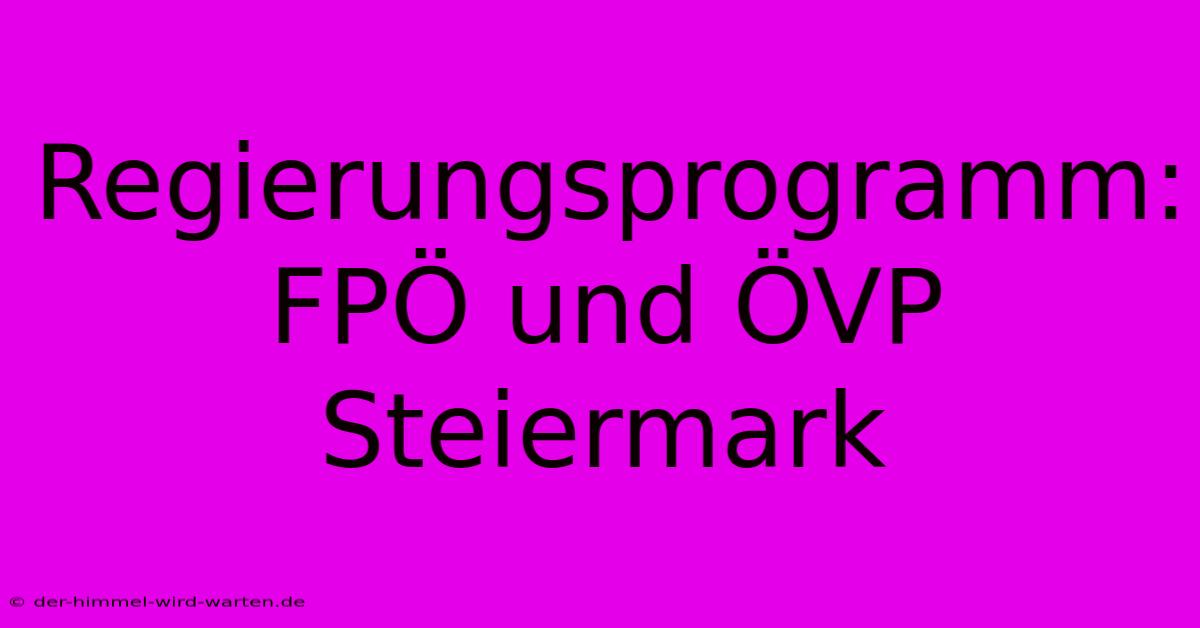Regierungsprogramm: FPÖ Und ÖVP Steiermark

Discover more detailed and exciting information on our website. Click the link below to start your adventure: Visit My Website. Don't miss out!
Table of Contents
Regierungsprogramm: FPÖ und ÖVP Steiermark – Ein Blick hinter die Kulissen
Hallo zusammen! Let's dive into the coalition agreement between the FPÖ and ÖVP in Styria (Steiermark), shall we? It's a pretty juicy topic, and honestly, I've spent the last few weeks knee-deep in this stuff. My head's spinning, but I've got some insights to share – some things I initially misunderstood, some victories, and some…well, let’s just say areas for improvement.
First off, finding reliable, up-to-date information was a total nightmare. I swear, I spent hours sifting through press releases, official websites (which were, frankly, a bit of a mess), and news articles, all written in that overly formal German that makes my eyes glaze over. One thing I learned quickly? Don't rely solely on the government's official website. Seriously, go to multiple sources – reputable news outlets, political analysis sites, the whole shebang. Cross-reference everything. You'll thank me later.
<h3>Key Promises and Policy Areas</h3>
The coalition agreement, as far as I can decipher it (and believe me, it's a thick document!), focuses heavily on a few key areas:
-
Wirtschaft und Arbeitsplätze: This section is packed with promises regarding job creation and economic growth. They talk about supporting SMEs (kleine und mittlere Unternehmen), attracting investment, and reducing bureaucracy. Sounds good, right? But the devil's in the details. How exactly do they plan to achieve this? That's where things get a bit fuzzy. More specific action plans would be great.
-
Bildung und Familie: The agreement emphasizes improvements in education and support for families. They mention things like increased childcare options and investment in schools. However, the specific funding allocations are, again, somewhat vague. I'm keeping my eye on this one.
-
Sicherheit: Not surprisingly, given the FPÖ's platform, security is a major focus. They mention increased police presence, stricter immigration policies, and combating crime. This is where I had my biggest initial misunderstanding. I initially thought it was all about harsher measures, but a closer look reveals some attempts at preventative measures too—more social work, community engagement. It’s a more nuanced approach than I first thought.
<h3>My Biggest Mistake and What I Learned</h3>
My biggest mistake? Assuming I could get a clear picture just by reading the official government document. It was a dense, jargon-filled wall of text. I needed to engage with other content creators to understand it better. I watched a few YouTube videos explaining the key aspects, that's when things started to click. Use diverse media formats. Don't just read – listen to podcasts, watch videos, engage with social media discussions (carefully!).
<h3>Practical Tips for Understanding the Regierungsprogramm</h3>
Here’s what I’ve learned that might help you, too:
- Break it down: Don't try to digest the entire document in one sitting. Focus on specific policy areas that interest you most.
- Compare and contrast: Check out analyses from different sources – left-leaning, right-leaning, and independent. This will provide a more well-rounded perspective.
- Look for the specifics: Don't just read the headlines. Dig deep and look for concrete plans, timelines, and budget allocations.
- Follow up: After a few months, revisit the agreement and see what progress has been made (or hasn't been made). This is crucial for accountability.
The FPÖ and ÖVP coalition agreement in Styria is complex, nuanced, and frankly, a bit of a headache to fully grasp. But with the right approach and a healthy dose of persistence, you can get a handle on it. And remember—always be critical, compare sources, and don’t be afraid to admit when you don’t fully understand something! This whole experience was a steep learning curve, but hey, at least I learned something, right?

Thank you for visiting our website wich cover about Regierungsprogramm: FPÖ Und ÖVP Steiermark. We hope the information provided has been useful to you. Feel free to contact us if you have any questions or need further assistance. See you next time and dont miss to bookmark.
Also read the following articles
| Article Title | Date |
|---|---|
| Vorsorgliche Schulschliessung Nrw Mpox | Dec 17, 2024 |
| Mudryk Dopingvorwurf Bei Chelsea | Dec 17, 2024 |
| Mehrere N Oe Schulen Bombendrohung | Dec 17, 2024 |
| Stille Katastrophe Ein Drohendes Problem | Dec 17, 2024 |
| Tatort Muenster Wie Gut Ist Thiels Neuer Fall | Dec 17, 2024 |
